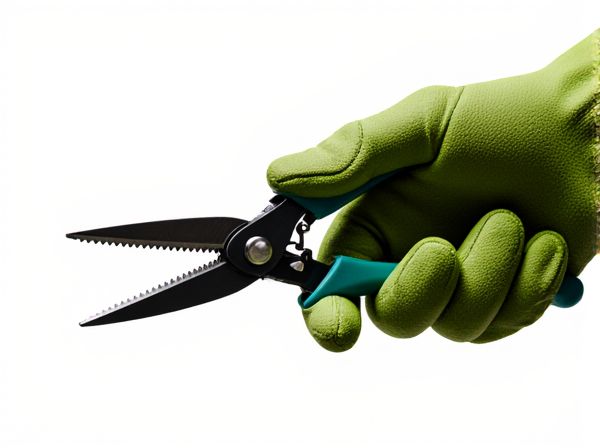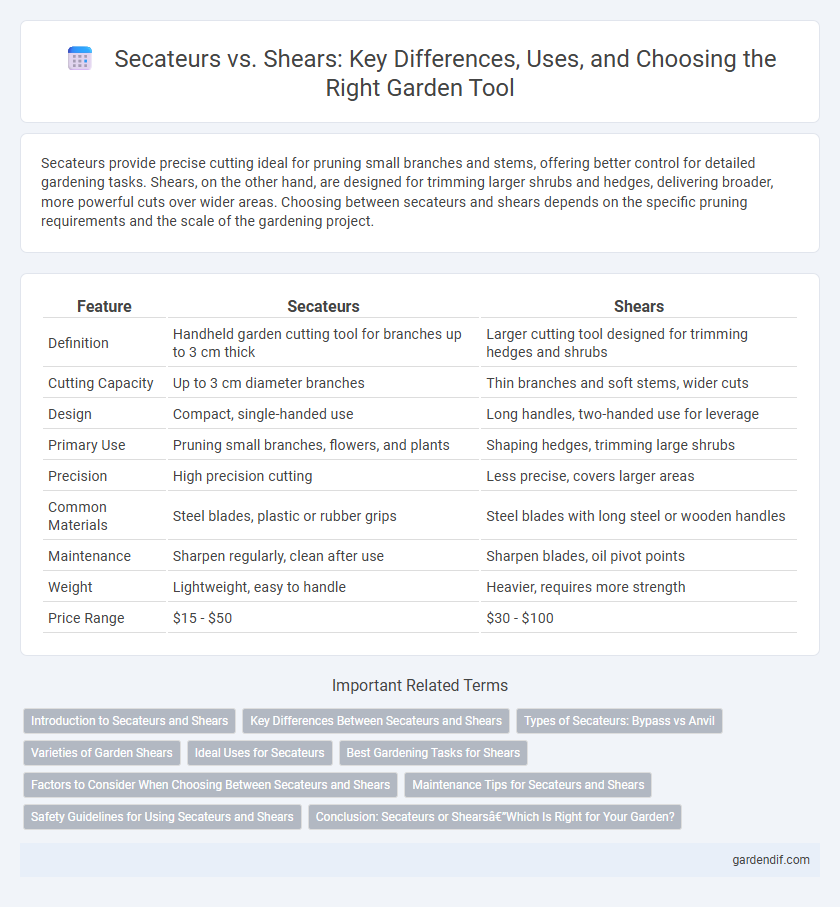
Secateurs vs Shears Illustration
Secateurs provide precise cutting ideal for pruning small branches and stems, offering better control for detailed gardening tasks. Shears, on the other hand, are designed for trimming larger shrubs and hedges, delivering broader, more powerful cuts over wider areas. Choosing between secateurs and shears depends on the specific pruning requirements and the scale of the gardening project.
Table of Comparison
| Feature | Secateurs | Shears |
|---|---|---|
| Definition | Handheld garden cutting tool for branches up to 3 cm thick | Larger cutting tool designed for trimming hedges and shrubs |
| Cutting Capacity | Up to 3 cm diameter branches | Thin branches and soft stems, wider cuts |
| Design | Compact, single-handed use | Long handles, two-handed use for leverage |
| Primary Use | Pruning small branches, flowers, and plants | Shaping hedges, trimming large shrubs |
| Precision | High precision cutting | Less precise, covers larger areas |
| Common Materials | Steel blades, plastic or rubber grips | Steel blades with long steel or wooden handles |
| Maintenance | Sharpen regularly, clean after use | Sharpen blades, oil pivot points |
| Weight | Lightweight, easy to handle | Heavier, requires more strength |
| Price Range | $15 - $50 | $30 - $100 |
Introduction to Secateurs and Shears
Secateurs are handheld pruning tools designed for precise cutting of small branches and stems, featuring sharp blades and ergonomic handles for efficient forestry and gardening tasks. Shears, larger than secateurs, provide powerful cutting leverage suited for trimming thicker foliage and shaping hedges, often used in landscaping and agricultural maintenance. Choosing between secateurs and shears depends on the plant size and task precision, with secateurs ideal for detailed pruning and shears better for extensive trimming.
Key Differences Between Secateurs and Shears
Secateurs feature a handheld design with a ratchet mechanism, allowing precise cuts on small branches and stems up to 3/4 inch in diameter, making them ideal for pruning and shaping plants. Shears typically have longer handles and blades designed for trimming larger, softer vegetation such as hedges and shrubs, providing greater leverage for cutting through thicker, more fibrous material. The key differences lie in size, cutting capacity, and intended use, with secateurs excelling in precise pruning and shears optimized for shaping and managing larger foliage.
Types of Secateurs: Bypass vs Anvil
Bypass secateurs feature two curved blades that pass by each other for clean, precise cuts ideal for live plants, while anvil secateurs have a straight blade that presses against a flat surface, suitable for cutting dead or hard stems. Bypass secateurs reduce plant damage and promote faster healing compared to anvil types, which are typically more durable and better for tougher pruning tasks. Selecting the right type depends on plant material and pruning needs, with bypass secateurs preferred for delicate work and anvil secateurs for heavy-duty applications.
Varieties of Garden Shears
Garden shears come in various types, including hedge shears, grass shears, and pruning shears, each designed for specific gardening tasks. Hedge shears feature long blades ideal for shaping shrubs, while grass shears provide precise trimming for lawn edges. Pruning shears, often smaller and more maneuverable, are used for cutting branches and stems, offering versatility beyond that of typical secateurs.
Ideal Uses for Secateurs
Secateurs are ideal for precision pruning of small branches and stems up to 3/4 inch thick, making them perfect for detailed gardening tasks like shaping shrubs and harvesting flowers. Their sharp, curved blades provide clean cuts that promote healthy plant growth and reduce damage. Secateurs are essential for gardeners seeking control and accuracy in maintaining the health and appearance of their plants.
Best Gardening Tasks for Shears
Shears are ideal for pruning hedges, trimming shrubs, and cutting through thicker branches that require more leverage than secateurs can provide. Their longer handles and larger blades enable precise shaping and maintain the health of larger plants by allowing clean cuts. Garden shears also excel at harvesting flowers and herbs, offering greater reach and control for detailed garden maintenance.
Factors to Consider When Choosing Between Secateurs and Shears
Choosing between secateurs and shears depends on factors such as the thickness and type of plant material, required precision, and ergonomic design. Secateurs are ideal for cutting thicker stems and branches up to 3/4 inch in diameter due to their robust and sharp blades. Shears excel at trimming softer plants and shaping hedges with their longer blades and longer reach, making the choice dependent on the specific gardening task and user comfort.
Maintenance Tips for Secateurs and Shears
Secateurs require regular sharpening with a sharpening stone or diamond file to maintain a clean cut and prevent plant damage, while shears benefit from blade alignment checks to ensure even cutting. Both tools should be cleaned after each use to remove sap and debris, using a mild detergent or rubbing alcohol to prevent rust. Oiling the pivot points of secateurs and shears regularly reduces friction and prolongs tool life, enhancing performance and durability.
Safety Guidelines for Using Secateurs and Shears
Using secateurs and shears requires following strict safety guidelines to prevent injuries such as cuts or punctures; always wear protective gloves and ensure blades are sharp for clean cuts. Maintain a firm grip and cut away from the body to minimize the risk of accidents, while keeping fingers clear of the blades during operation. Regularly inspect tools for damage, lubricate moving parts, and store them safely to preserve tool integrity and user safety.
Conclusion: Secateurs or Shears—Which Is Right for Your Garden?
Secateurs are ideal for precision pruning of small branches and delicate plants, providing clean cuts that promote healthy growth. Shears excel at trimming larger shrubs and hedges, efficiently shaping green spaces with their long blades. Choosing between secateurs and shears depends on your garden's specific needs for size and type of vegetation.
Secateurs vs Shears Infographic

 gardendif.com
gardendif.com